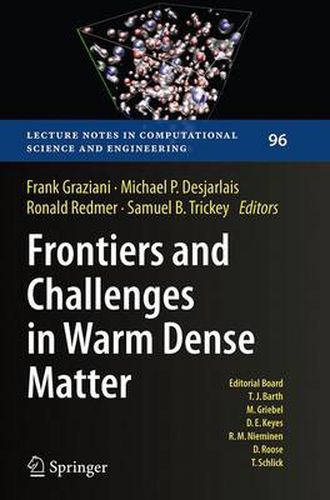Readings Newsletter
Become a Readings Member to make your shopping experience even easier.
Sign in or sign up for free!
You’re not far away from qualifying for FREE standard shipping within Australia
You’ve qualified for FREE standard shipping within Australia
The cart is loading…






This title is printed to order. This book may have been self-published. If so, we cannot guarantee the quality of the content. In the main most books will have gone through the editing process however some may not. We therefore suggest that you be aware of this before ordering this book. If in doubt check either the author or publisher’s details as we are unable to accept any returns unless they are faulty. Please contact us if you have any questions.
Warm Dense Matter (WDM) occupies a loosely defined region of phase space intermediate between solid, liquid, gas, and plasma, and typically shares characteristics of two or more of these phases. WDM is generally associated with the combination of strongly coupled ions and moderately degenerate electrons, and careful attention to quantum physics and electronic structure is essential. The lack of a small perturbation parameter greatly limits approximate attempts at its accurate description. Since WDM resides at the intersection of solid state and high energy density physics, many high energy density physics (HEDP) experiments pass through this difficult region of phase space. Thus, understanding and modeling WDM is key to the success of experiments on diverse facilities. These include the National Ignition Campaign centered on the National Ignition Facility (NIF), pulsed-power driven experiments on the Z machine, ion-beam-driven WDM experiments on the NDCX-II, and fundamental WDM research at the Linear Coherent Light Source (LCLS). Warm Dense Matter is also ubiquitous in planetary science and astrophysics, particularly with respect to unresolved questions concerning the structure and age of the gas giants, the nature of exosolar planets, and the cosmochronology of white dwarf stars. In this book we explore established and promising approaches to the modeling of WDM, foundational issues concerning the correct theoretical description of WDM, and the challenging practical issues of numerically modeling strongly coupled systems with many degrees of freedom.
$9.00 standard shipping within Australia
FREE standard shipping within Australia for orders over $100.00
Express & International shipping calculated at checkout
This title is printed to order. This book may have been self-published. If so, we cannot guarantee the quality of the content. In the main most books will have gone through the editing process however some may not. We therefore suggest that you be aware of this before ordering this book. If in doubt check either the author or publisher’s details as we are unable to accept any returns unless they are faulty. Please contact us if you have any questions.
Warm Dense Matter (WDM) occupies a loosely defined region of phase space intermediate between solid, liquid, gas, and plasma, and typically shares characteristics of two or more of these phases. WDM is generally associated with the combination of strongly coupled ions and moderately degenerate electrons, and careful attention to quantum physics and electronic structure is essential. The lack of a small perturbation parameter greatly limits approximate attempts at its accurate description. Since WDM resides at the intersection of solid state and high energy density physics, many high energy density physics (HEDP) experiments pass through this difficult region of phase space. Thus, understanding and modeling WDM is key to the success of experiments on diverse facilities. These include the National Ignition Campaign centered on the National Ignition Facility (NIF), pulsed-power driven experiments on the Z machine, ion-beam-driven WDM experiments on the NDCX-II, and fundamental WDM research at the Linear Coherent Light Source (LCLS). Warm Dense Matter is also ubiquitous in planetary science and astrophysics, particularly with respect to unresolved questions concerning the structure and age of the gas giants, the nature of exosolar planets, and the cosmochronology of white dwarf stars. In this book we explore established and promising approaches to the modeling of WDM, foundational issues concerning the correct theoretical description of WDM, and the challenging practical issues of numerically modeling strongly coupled systems with many degrees of freedom.